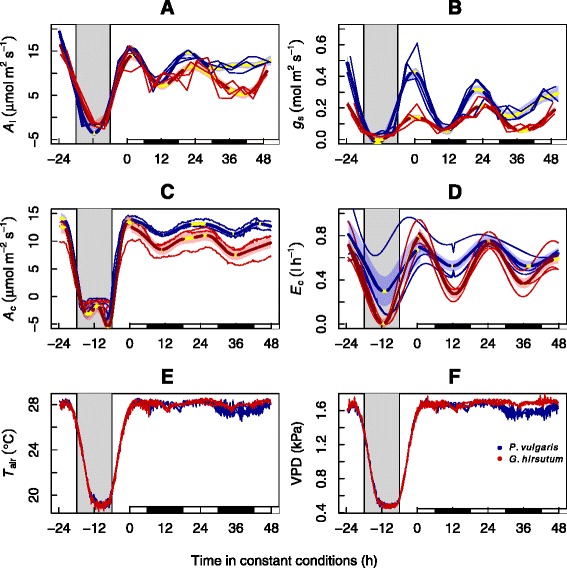Fig. 1.

Circadian regulation of leaf and canopy-scale CO2 and H2O fluxes. We grew cotton (Gossypium hirsutum) and bean (Phaseolus vulgaris) in experimental macrocosms at the Montpellier European Ecotron. During experimental conditions, temperature (T air, e) and vapor pressure deficit (VPD, f) mimicked the environmental conditions of an average August day in Montpellier, with 500 μmol m−2 s−1 photosynthetically active respiration (PAR) (first 24 h shown) remaining constant for the following 48 h starting at solar noon. Grey or white background indicate when PAR was at or above 0 μmol m−2 s−1 respectively. The white and black rectangles at the base indicate the subjective day (when it would have been daytime during entrainment) and subjective night, respectively, under constant conditions. Thin lines represent measured values at each of three replicate macrocosms, and thick lines (and shaded error intervals) indicate the prediction (and SE) of generalized additive mixed model (GAMM) fitting separately for each species (some lines may overlap). Portions of the thick line in yellow indicate lack of statistical variation in the slope. Significant variation (GAMM best-fit line portions not yellow) in leaf (a) and canopy (c) carbon assimilation (A l and A c, respectively), stomatal conductance (g s, b) and canopy transpiration (E c, d) prevailed for all fluxes and processes, at least in the first 24 h under constant conditions. This can be fully attributed to circadian action. Clock regulation is plastic and may relax after prolonged exposures to constant conditions [56]. Negative dark-time values of A l/g s and A c/E c were cropped as they lack biological meaning
